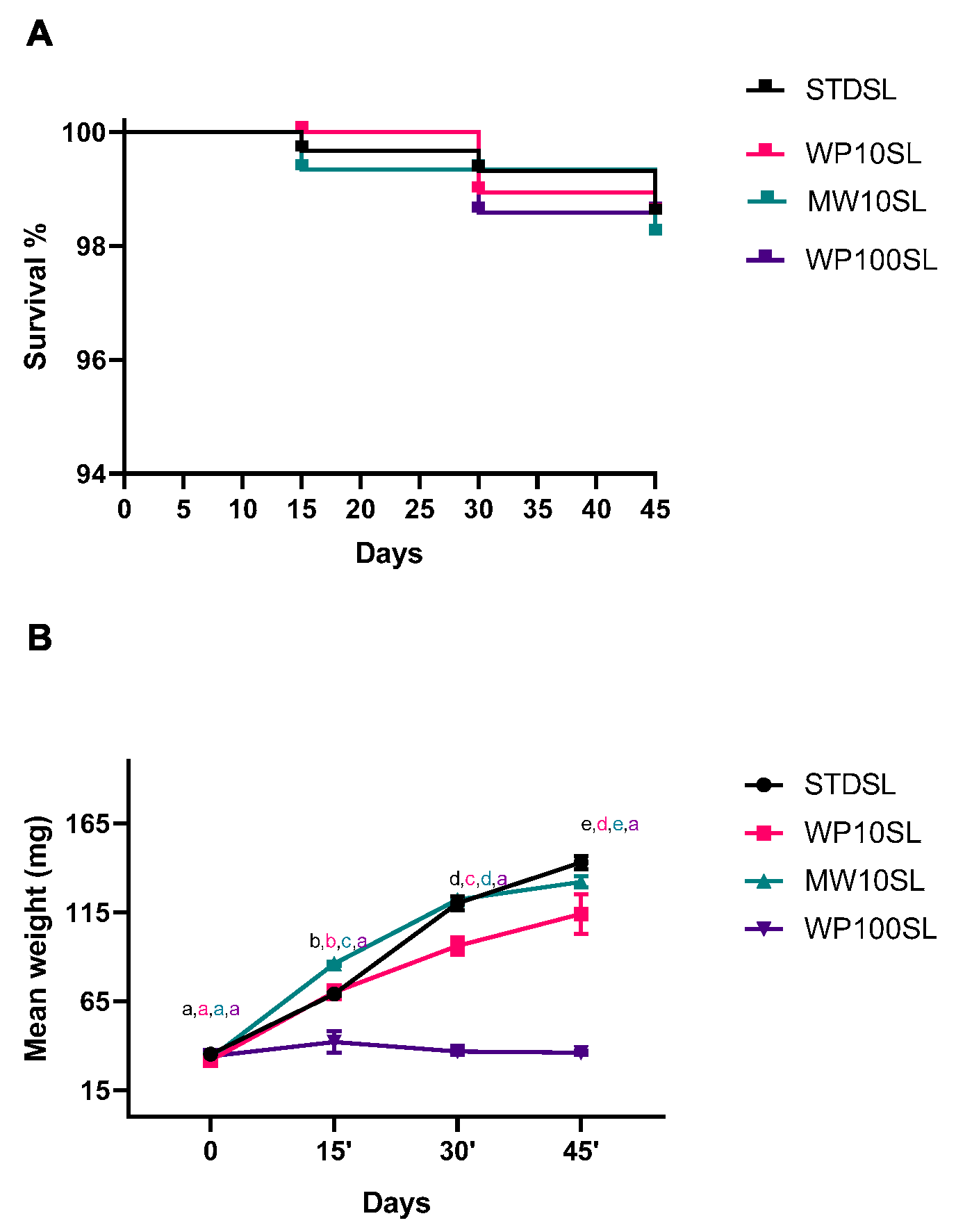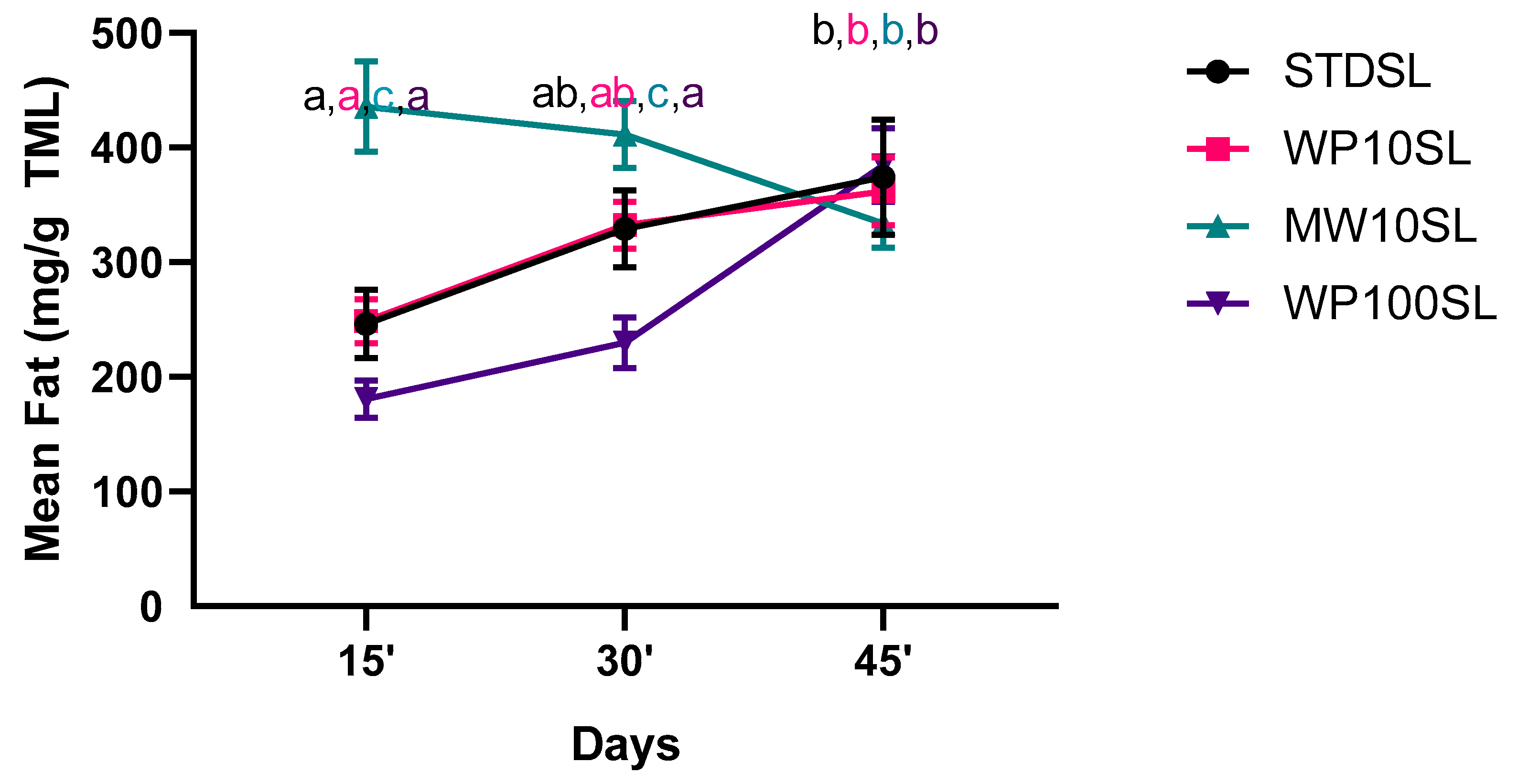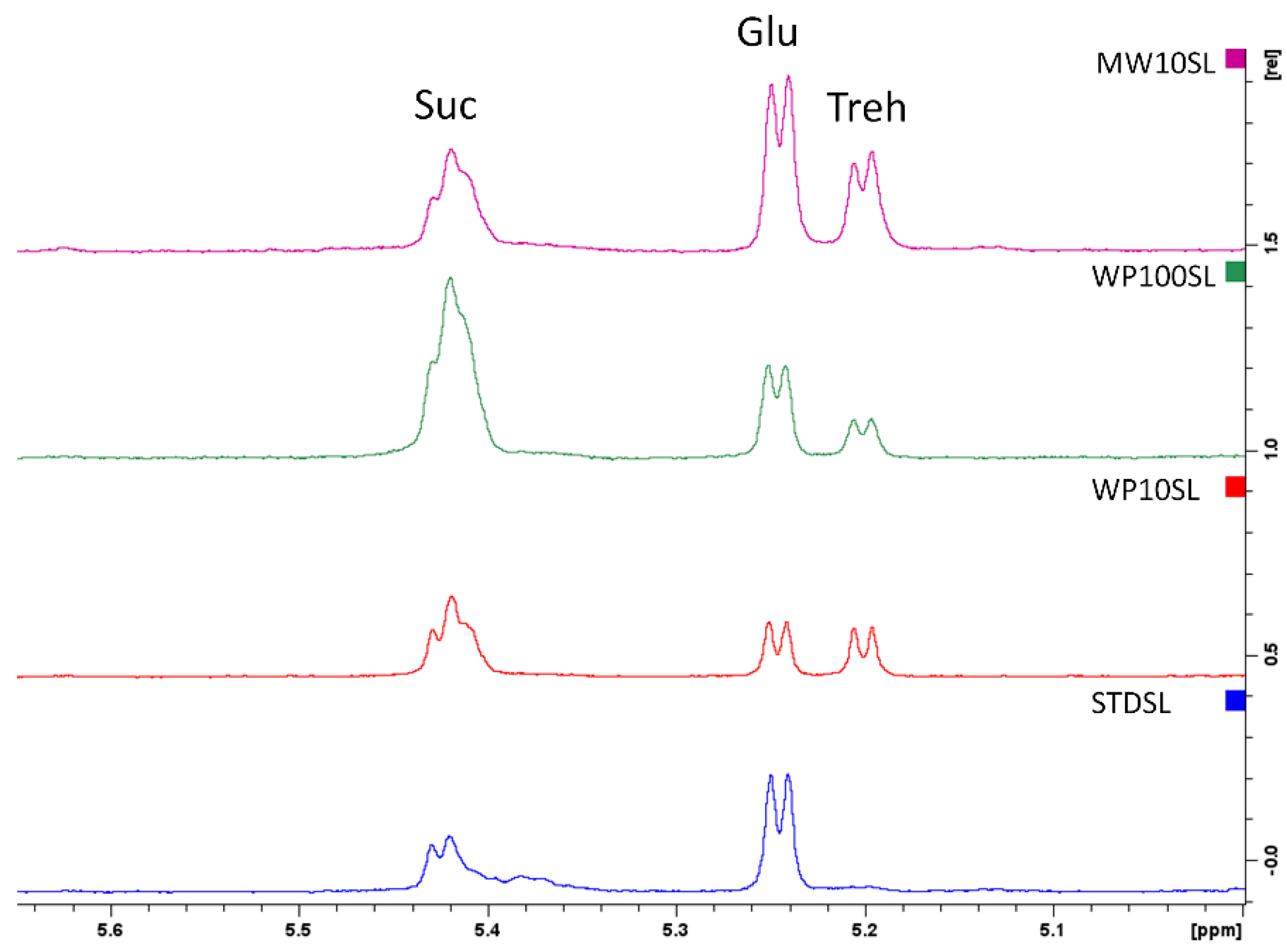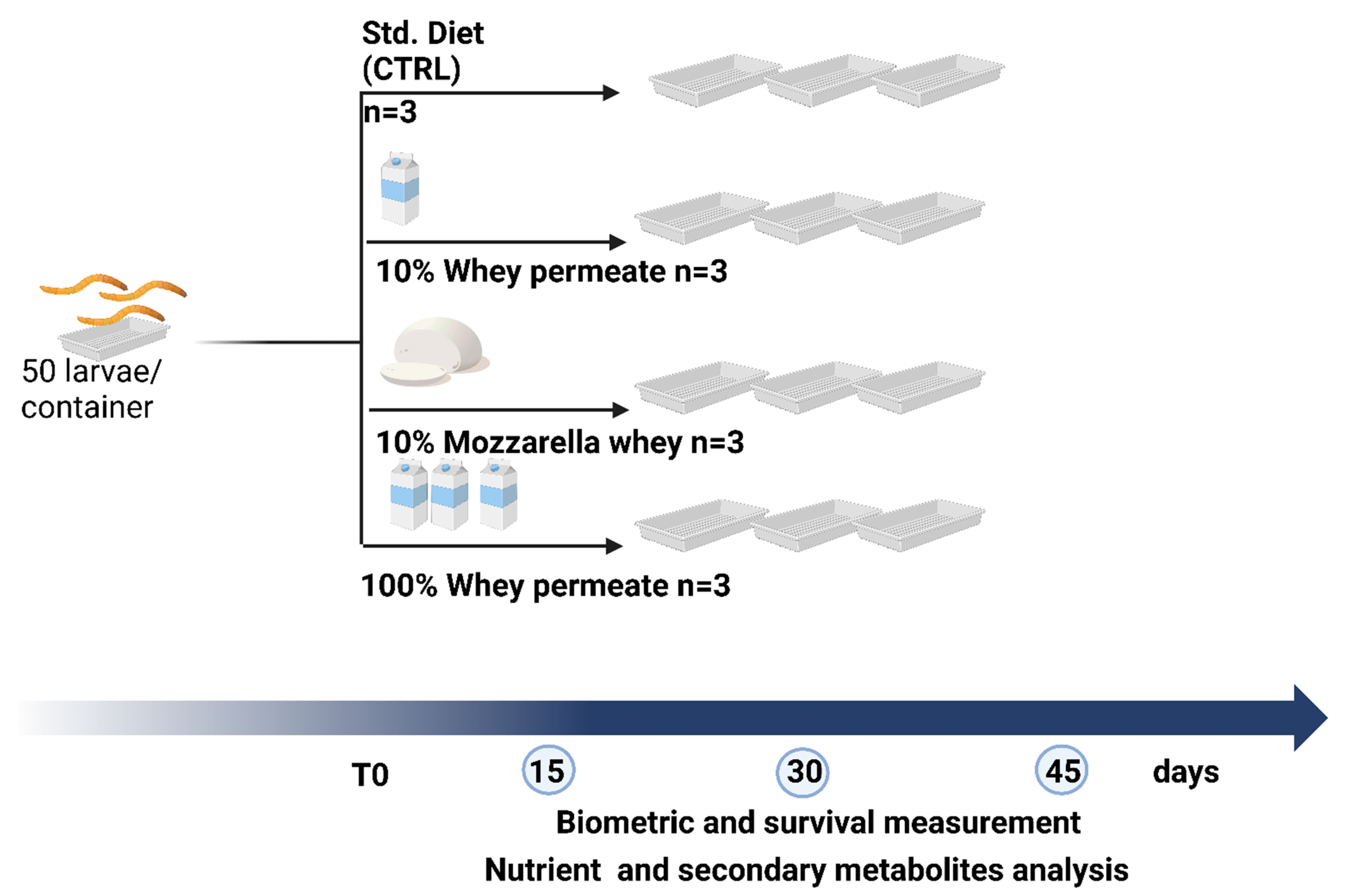Upcycling Milk Industry Byproducts into Tenebrio molitor Larvae: Investigation on Fat, Protein, and Sugar Composition
Abstract
1. Introduction
2. Results and Discussion
2.1. Analysis of Byproducts
2.2. Analysis of Survival Rate and Body Weight
2.3. Analysis of Proximate Composition
2.4. Analysis of Fat
2.5. Analysis of Polar Secondary Metabolites
3. Materials and Methods
3.1. Materials
3.2. Design of the Experiment
3.3. Extraction of Polar Metabolites
3.4. Total Lipid Content Determination
3.5. Analysis of Nutrients
3.6. NMR Analysis
3.7. Fatty Acid Determination
3.8. Lipid Quality Indices Determination
3.9. Statistical Analysis
4. Conclusions
Supplementary Materials
Author Contributions
Funding
Institutional Review Board Statement
Informed Consent Statement
Data Availability Statement
Conflicts of Interest
References
- FAO; IFAD; UNICEF; WFP; WHO. The State of Food Security and Nutrition in the World 2021; FAO, Ed.; FAO: Rome, Italy; IFAD: Rome, Italy; UNICEF: New York, NY, USA; WFP: Rome, Italy; WHO: Geneva, Switzerland, 2021. [Google Scholar]
- Malek, L.; Umberger, W.J. Protein Source Matters: Understanding Consumer Segments with Distinct Preferences for Alternative Proteins. Future Foods 2023, 7, 100220. [Google Scholar] [CrossRef]
- Jang, K.B.; Purvis, J.M.; Kim, S.W. Dose-Response and Functional Role of Whey Permeate as a Source of Lactose and Milk Oligosaccharides on Intestinal Health and Growth of Nursery Pigs. J. Anim. Sci. 2021, 99, 338. [Google Scholar] [CrossRef]
- Pam Ismail, B.; Senaratne-Lenagala, L.; Stube, A.; Brackenridge, A. Protein Demand: Review of Plant and Animal Proteins Used in Alternative Protein Product Development and Production. Anim. Front. 2020, 10, 53–63. [Google Scholar] [CrossRef]
- Hadidi, M.; Hossienpour, Y.; Nooshkam, M.; Mahfouzi, M.; Gharagozlou, M.; Aliakbari, F.S.; Aghababaei, F.; McClement, D.J. Green Leaf Proteins: A Sustainable Source of Edible Plant-Based Proteins. Crit. Rev. Food Sci. Nutr. 2023, 64, 10855–10872. [Google Scholar] [CrossRef]
- Biscarra-Bellio, J.C.; de Oliveira, G.B.; Marques, M.C.P.; Molento, C.F.M. Demand Changes Meat as Changing Meat Reshapes Demand: The Great Meat Revolution. Meat Sci. 2023, 196, 109040. [Google Scholar] [CrossRef] [PubMed]
- Gravel, A.; Doyen, A. The Use of Edible Insect Proteins in Food: Challenges and Issues Related to Their Functional Properties. Innov. FSET 2020, 59, 102272. [Google Scholar] [CrossRef]
- van HUIS, A.; Arnold van Huis, C. Edible Insects: Challenges and Prospects. Entomol. Res. 2022, 52, 161–177. [Google Scholar] [CrossRef]
- Jantzen da Silva Lucas, A.; Menegon de Oliveira, L.; da Rocha, M.; Prentice, C. Edible Insects: An Alternative of Nutritional, Functional and Bioactive Compounds. Food Chem. 2020, 311, 126022. [Google Scholar] [CrossRef]
- Ordoñez-Araque, R.; Egas-Montenegro, E. Edible Insects: A Food Alternative for the Sustainable Development of the Planet. Int. J. Gastron. Food Sci. 2021, 23, 100304. [Google Scholar] [CrossRef]
- Malla, N.; Nørgaard, J.V.; Laerke, H.N.; Heckmann, L.-H.L.; Roos, N. Some Insect Species Are Good-Quality Protein Sources for Children and Adults: Digestible Indispensable Amino Acid Score (DIAAS) Determined in Growing Pigs. J. Nutr. 2022, 152, 1042–1051. [Google Scholar] [CrossRef]
- Rumpold, B.A.; Schlüter, O.K. Nutritional Composition and Safety Aspects of Edible Insects. Mol. Nutr. Food Res. 2013, 57, 802–823. [Google Scholar] [CrossRef] [PubMed]
- EFSA Panel on Nutrition Novel Foods and Food Allergens Safety of Dried Yellow Mealworm (Tenebrio molitor Larva) as a Novel Food Pursuant to Regulation (EU) 2015/2283. EFSA J. 2021, 19, 6343.
- Brai, A.; Trivisani, C.I.; Vagaggini, C.; Stella, R.; Angeletti, R.; Iovenitti, G.; Francardi, V.; Dreassi, E. Proteins from Tenebrio molitor: An Interesting Functional Ingredient and a Source of ACE Inhibitory Peptides. Food Chem. 2022, 393, 133409. [Google Scholar] [CrossRef] [PubMed]
- Choi, R.Y.; Ham, J.R.; Ryu, H.S.; Lee, S.S.; Miguel, M.A.; Paik, M.J.; Ji, M.; Park, K.W.; Kang, K.Y.; Lee, H.I.; et al. Defatted Tenebrio molitor Larva Fermentation Extract Modifies Steatosis, Inflammation and Intestinal Microflora in Chronic Alcohol-Fed Rats. Nutrients 2020, 12, 1426. [Google Scholar] [CrossRef]
- de Souza, P.C.; Morey, A.T.; Castanheira, G.M.; Bocate, K.P.; Panagio, L.A.; Ito, F.A.; Furlaneto, M.C.; Yamada-Ogatta, S.F.; Costa, I.N.; Mora-Montes, H.M.; et al. Tenebrio molitor (Coleoptera: Tenebrionidae) as an Alternative Host to Study Fungal Infections. J. Microbiol. Methods 2015, 118, 182–186. [Google Scholar] [CrossRef]
- de Carvalho, N.M.; Walton, G.E.; Poveda, C.G.; Silva, S.N.; Amorim, M.; Madureira, A.R.; Pintado, M.E.; Gibson, G.R.; Jauregi, P. Study of in Vitro Digestion of Tenebrio molitor Flour for Evaluation of Its Impact on the Human Gut Microbiota. J. Funct. Foods 2019, 59, 101–109. [Google Scholar] [CrossRef]
- Errico, S.; Spagnoletta, A.; Verardi, A.; Moliterni, S.; Dimatteo, S.; Sangiorgio, P. Tenebrio molitor as a Source of Interesting Natural Compounds, Their Recovery Processes, Biological Effects, and Safety Aspects. Compr. Rev. Food Sci. Food Saf. 2022, 21, 148–197. [Google Scholar] [CrossRef]
- Ding, Q.; Wu, R.A.; Shi, T.; Yu, Y.; Yan, Y.; Sun, N.; Sheikh, A.R.; Luo, L.; He, R.; Ma, H. Antiproliferative Effects of Mealworm Larvae (Tenebrio molitor) Aqueous Extract on Human Colorectal Adenocarcinoma (Caco-2) and Hepatocellular Carcinoma (HepG2) Cancer Cell Lines. J. Food Biochem. 2021, 45, e13778. [Google Scholar] [CrossRef]
- Seo, M.; Goo, T.W.; Chung, M.Y.; Baek, M.; Hwang, J.S.; Kim, M.A.; Yun, E.Y. Tenebrio molitor Larvae Inhibit Adipogenesis through AMPK and MAPKs Signaling in 3T3-L1 Adipocytes and Obesity in High-Fat Diet-Induced Obese Mice. Int. J. Mol. Sci. 2017, 18, 518. [Google Scholar] [CrossRef]
- Vercruysse, L.; Van Camp, J.; Smagghe, G. ACE Inhibitory Peptides Derived from Enzymatic Hydrolysates of Animal Muscle Protein: A Review. J. Agric. Food Chem. 2005, 53, 8106–8115. [Google Scholar] [CrossRef]
- Pihlanto-Leppälä, A. Bioactive Peptides Derived from Bovine Whey Proteins: Opioid and Ace-Inhibitory Peptides. Trends Food Sci. Technol. 2000, 11, 347–356. [Google Scholar] [CrossRef]
- Guang, C.; Phillips, R.D. Plant Food-Derived Angiotensin I Converting Enzyme Inhibitory Peptides. J. Agric. Food Chem. 2009, 57, 5113–5120. [Google Scholar] [CrossRef] [PubMed]
- Dujardin, B.; Ferreira de Sousa, R.; Gómez Ruiz, J.Á. Dietary Exposure to Heavy Metals and Iodine Intake via Consumption of Seaweeds and Halophytes in the European Population. EFSA J. 2023, 21, e07798. [Google Scholar] [CrossRef] [PubMed]
- Sá Monteiro, M.; Sloth, J.; Holdt, S.; Hansen, M. Analysis and Risk Assessment of Seaweed. EFSA J. 2019, 17, e170915. [Google Scholar] [CrossRef] [PubMed]
- Kotsou, K.; Chatzimitakos, T.; Athanasiadis, V.; Bozinou, E.; Adamaki-Sotiraki, C.; Rumbos, C.I.; Athanassiou, C.G.; Lalas, S.I. Waste Orange Peels as a Feed Additive for the Enhancement of the Nutritional Value of Tenebrio molitor. Foods 2023, 12, 783. [Google Scholar] [CrossRef] [PubMed]
- Yakti, W.; Förster, N.; Müller, M.; Mewis, I.; Ulrichs, C. Hemp Waste as a Substrate for Hermetia illucens (L.) (Diptera: Stratiomyidae) and Tenebrio molitor L. (Coleoptera: Tenebrionidae) Rearing. Insects 2023, 14, 183. [Google Scholar] [CrossRef]
- Harsányi, E.; Juhász, C.; Kovács, E.; Huzsvai, L.; Pintér, R.; Fekete, G.; Varga, Z.I.; Aleksza, L.; Gyuricza, C. Evaluation of Organic Wastes as Substrates for Rearing Zophobas morio, Tenebrio molitor, and Acheta domesticus Larvae as Alternative Feed Supplements. Insects 2020, 11, 604. [Google Scholar] [CrossRef]
- Brai, A.; Poggialini, F.; Trivisani, C.I.; Vagaggini, C.; Tarchi, F.; Francardi, V.; Dreassi, E. Efficient Use of Agricultural Waste to Naturally Fortify Tenebrio molitor Mealworms and Evaluation of Their Nutraceutical Properties. J. Insects Food Feed. 2023, 9, 599–610. [Google Scholar] [CrossRef]
- Przemieniecki, S.W.; Kosewska, A.; Ciesielski, S.; Kosewska, O. Changes in the Gut Microbiome and Enzymatic Profile of Tenebrio molitor Larvae Biodegrading Cellulose, Polyethylene and Polystyrene Waste. Environ. Pollut. 2020, 256, 113265. [Google Scholar] [CrossRef]
- Mancini, S.; Fratini, F.; Turchi, B.; Mattioli, S.; Dal Bosco, A.; Tuccinardi, T.; Nozic, S.; Paci, G. Former Foodstuff Products in Tenebrio molitor Rearing: Effects on Growth, Chemical Composition, Microbiological Load, and Antioxidant Status. Animals 2019, 9, 484. [Google Scholar] [CrossRef]
- Brai, A.; Vagaggini, C.; Pasqualini, C.; Poggialini, F.; Tarchi, F.; Francardi, V.; Dreassi, E. Use of Distillery By-Products as Tenebrio molitor Mealworm Feed Supplement. J. Insects Food Feed. 2023, 9, 611–623. [Google Scholar] [CrossRef]
- Andreadis, S.S.; Panteli, N.; Mastoraki, M.; Rizou, E.; Stefanou, V.; Tzentilasvili, S.; Sarrou, E.; Chatzifotis, S.; Krigas, N.; Antonopoulou, E. Towards Functional Insect Feeds: Agri-Food by-Products Enriched with Post-Distillation Residues of Medicinal Aromatic Plants in Tenebrio molitor (Coleoptera: Tenebrionidae) Breeding. Antioxidants 2022, 11, 68. [Google Scholar] [CrossRef] [PubMed]
- Morales-Ramos, J.A.; Rojas, M.G.; Shapiro-Nan, D.I.; Tedders, W.L. Developmental Plasticity in Tenebrio molitor (Coleoptera: Tenebrionidae): Analysis of Instar Variation in Number and Development Time under Different Diets. J. Entomol. Sci. 2010, 45, 75–90. [Google Scholar] [CrossRef]
- George, D.R.; Sparagano, O.A.E.; Port, G.; Okello, E.; Shiel, R.S.; Guy, J.H. Repellence of Plant Essential Oils to Dermanyssus Gallinae and Toxicity to the Non-Target Invertebrate Tenebrio molitor. Vet. Parasitol. 2009, 162, 129–134. [Google Scholar] [CrossRef]
- Plata-Rueda, A.; Cola Zanuncio, J.; Eduardo Serrão, J.; Carlos Martínez, L.; Benelli, G. Origanum Vulgare Essential Oil against Tenebrio molitor (Coleoptera: Tenebrionidae): Composition, Insecticidal Activity, and Behavioral Response. Plants 2021, 10, 2513. [Google Scholar] [CrossRef]
- Plata-Rueda, A.; Martínez, L.C.; Dos Santos, M.H.; Fernandes, F.L.; Wilcken, C.F.; Soares, M.A.; Serrão, J.E.; Zanuncio, J.C. Insecticidal Activity of Garlic Essential Oil and Their Constituents against the Mealworm Beetle, Tenebrio molitor Linnaeus (Coleoptera: Tenebrionidae). Sci. Rep. 2017, 7, srep46406. [Google Scholar] [CrossRef]
- Rebouillat, S.; Ortega-Requena, S. Potential Applications of Milk Fractions and Valorization of Dairy By-Products: A Review of the State-of-the-Art Available Data, Outlining the Innovation Potential from a Bigger Data Standpoint. J. Biomater. Nanobiotechnol 2015, 6, 176–203. [Google Scholar] [CrossRef]
- Menchik, P.; Zuber, T.; Zuber, A.; Moraru, C.I. Short Communication: Composition of Coproduct Streams from Dairy Processing: Acid Whey and Milk Permeate. J. Dairy. Sci. 2019, 102, 3978–3984. [Google Scholar] [CrossRef] [PubMed]
- O’Donoghue, L.T.; Murphy, E.G. Nondairy Food Applications of Whey and Milk Permeates: Direct and Indirect Uses. Compr. Rev. Food Sci. Food Saf. 2023, 22, 2652–2677. [Google Scholar] [CrossRef]
- Barile, D.; Tao, N.; Lebrilla, C.B.; Coisson, J.D.; Arlorio, M.; German, J.B. Permeate from Cheese Whey Ultrafiltration Is a Source of Milk Oligosaccharides. Int. Dairy. J. 2009, 19, 524–530. [Google Scholar] [CrossRef]
- Gernigon, G.; Piot, M.; Beaucher, E.; Jeantet, R.; Schuck, P. Physicochemical Characterization of Mozzarella Cheese Wheys and Stretchwaters in Comparison with Several Other Sweet Wheys. J. Dairy. Sci. 2009, 92, 5371–5377. [Google Scholar] [CrossRef] [PubMed]
- Hu, M.; Kurth, M.J.; Hsieh, Y.L.; Krochta, J.M. HPLC and NMR Study of the Reduction of Sweet Whey Permeate. J. Agric. Food Chem. 1996, 44, 3757–3762. [Google Scholar] [CrossRef]
- Anderson, M.J.; Lamb, R.C.; Mickelsen, C.H.; Wiscombe, R.L. Feeding Liquid Whey to Dairy Cattle. J. Dairy. Sci. 1974, 57, 1206–1210. [Google Scholar] [CrossRef]
- Caltzontzin-Rabell, V.; Escobar-Ortiz, A.; Gutiérrez-Antonio, C.; Feregrino-Pérez, A.A.; García-Trejo, J.F. Revaluation Process of Cheese Whey through the Cultivation of Black Soldier Fly Larvae (Hermetia illucens). Eng. Rep. 2024, 6, e12853. [Google Scholar] [CrossRef]
- Caltzontzin-Rabell, V.; Feregrino-Pérez, A.A.; Gutiérrez-Antonio, C. Bio-Upcycling of Cheese Whey: Transforming Waste into Raw Materials for Biofuels and Animal Feed. Heliyon 2024, 10, 32700. [Google Scholar] [CrossRef] [PubMed]
- Brai, A.; Provenzani, M.P.; Pasqualini, C.; Poggialini, F.; Vagaggini, C.; Tarchi, F.; Frosinini, R.; Francardi, V.; Simoni, S.; Dreassi, E. Exploiting Fall Foliage By-Products to Optimize Tenebrio molitor Nutraceutical Value. J. Insects Food Feed. 2023, 93, 959–976. [Google Scholar] [CrossRef]
- Abdelatti, Z.A.S.; Hartbauer, M. Plant Oil Mixtures as a Novel Botanical Pesticide to Control Gregarious Locusts. J. Pest Sci. 2020, 93, 341–353. [Google Scholar] [CrossRef]
- Janssen, R.H.; Vincken, J.P.; Van Den Broek, L.A.M.; Fogliano, V.; Lakemond, C.M.M. Nitrogen-to-Protein Conversion Factors for Three Edible Insects: Tenebrio molitor, Alphitobius Diaperinus, and Hermetia illucens. J. Agric. Food Chem. 2017, 65, 2275–2278. [Google Scholar] [CrossRef]
- Ferri, I.; Dell’Anno, M.; Spano, M.; Canala, B.; Petrali, B.; Dametti, M.; Magnaghi, S.; Rossi, L. Characterisation of Tenebrio molitor Reared on Substrates Supplemented with Chestnut Shell. Insects 2024, 15, 512. [Google Scholar] [CrossRef]
- Martins da Silva, R.; Köhler, A.; de Cássia de Souza Schneider, R.; Prado de Vargas, D.; Lúcia Köhler, A.; da Costa e Silva, D.; Soares, J. Proximate and Fatty Acid Profile Analysis of Tenebrio molitor and Zophobas Morio Using Different Killing Methods. Food Chem. 2024, 445, 138719. [Google Scholar] [CrossRef]
- Kotsou, K.; Chatzimitakos, T.; Athanasiadis, V.; Bozinou, E.; Rumbos, C.I.; Athanassiou, C.G.; Lalas, S.I. Enhancing the Nutritional Profile of Tenebrio molitor Using the Leaves of Moringa Oleifera. Foods 2023, 12, 2612. [Google Scholar] [CrossRef] [PubMed]
- FoodData Central. Available online: https://fdc.nal.usda.gov/fdc-app.html#/food-search?query=lamb&type=SR%20Legacy (accessed on 17 September 2024).
- Amawi, A.; Alkasasbeh, W.; Jaradat, M.; Almasri, A.; Alobaidi, S.; Hammad, A.A.; Bishtawi, T.; Fataftah, B.; Turk, N.; Al Saoud, H.; et al. Athletes’ Nutritional Demands: A Narrative Review of Nutritional Requirements. Front. Nutr. 2024, 10, 1331854. [Google Scholar] [CrossRef] [PubMed]
- Pelly, F.E.; Thurecht, R. Evaluation of Athletes’ Food Choices during Competition with Use of Digital Images. Nutrients 2019, 11, 1627. [Google Scholar] [CrossRef] [PubMed]
- Ibrahim, S.A.; Ayad, A.A.; Williams, L.L.; Ayivi, R.D.; Gyawali, R.; Krastanov, A.; Aljaloud, S.O. Date Fruit: A Review of the Chemical and Nutritional Compounds, Functional Effects and Food Application in Nutrition Bars for Athletes. Int. J. Food Sci. Technol. 2021, 56, 1503–1513. [Google Scholar] [CrossRef]
- Pipoyan, D.; Stepanyan, S.; Stepanyan, S.; Beglaryan, M.; Costantini, L.; Molinari, R.; Merendino, N. The Effect of Trans Fatty Acids on Human Health: Regulation and Consumption Patterns. Foods 2021, 10, 2452. [Google Scholar] [CrossRef] [PubMed]
- World Health Organization. Cardiovascular Diseases (CVDs). Available online: https://www.who.int/news-room/fact-sheets/detail/cardiovascular-diseases-(cvds) (accessed on 9 November 2021).
- Di Chiara, T.; Scaglione, A.; Corrao, S.; Argano, C.; Pinto, A.; Scaglione, R. Education and Hypertension: Impact on Global Cardiovascular Risk. Acta Cardiol. 2017, 72, 507–513. [Google Scholar] [CrossRef]
- Fasel, N.J.; Mè Ne-Saffrané, L.; Ruczyński, I.; Komar, E.; Christe, P. Diet Induced Modifications of Fatty-Acid Composition in Mealworm Larvae (Tenebrio molitor). J. Food Res. 2017, 6, 22. [Google Scholar] [CrossRef]
- Sánchez-Muros, M.J.; Barroso, F.G.; Manzano-Agugliaro, F. Insect Meal as Renewable Source of Food for Animal Feeding: A Review. J. Clean. Prod. 2014, 65, 16–27. [Google Scholar] [CrossRef]
- Canavoso, L.E.; Jouni, Z.E.; Karnas, K.J.; Pennington, J.E.; Wells, M.A. Fat Metabolism in Insects. Annu. Rev. Nutr. 2001, 21, 23–46. [Google Scholar] [CrossRef]
- Degirolamo, C.; Rudel, L.L. Dietary Monounsaturated Fatty Acids Appear Not to Provide Cardioprotection. Curr. Atheroscler. Rep. 2010, 12, 391–396. [Google Scholar] [CrossRef]
- Jakobsen, M.U.; O’Reilly, E.J.; Heitmann, B.L.; Pereira, M.A.; Bälter, K.; Fraser, G.E.; Goldbourt, U.; Hallmans, G.; Knekt, P.; Liu, S.; et al. Major Types of Dietary Fat and Risk of Coronary Heart Disease: A Pooled Analysis of 11 Cohort Studies. Am. J. Clin. Nutr. 2009, 89, 1425. [Google Scholar] [CrossRef] [PubMed]
- Brai, A.; Tarchi, F.; Pasqualini, C.; Poggialini, F.; Vagaggini, C.; Frosinini, R.; Simoni, S.; Francardi, V.; Dreassi, E. The Replacement Of Flour-Based Feed with Pellets Reduces Dustiness and Improves Tenebrio molitor Breeders’ Safety. Redia 2023, 106, 133–140. [Google Scholar] [CrossRef]
- Lawal, K.G.; Kavle, R.R.; Akanbi, T.O.; Mirosa, M.; Agyei, D. Enrichment in Specific Fatty Acids Profile of Tenebrio molitor and Hermetia illucens Larvae through Feeding. Future Foods 2021, 3, 100016. [Google Scholar] [CrossRef]
- Ulbricht, T.L.V.; Southgate, D.A.T. Coronary Heart Disease: Seven Dietary Factors. Lancet 1991, 338, 985–992. [Google Scholar] [CrossRef]
- Kumar, M.; Kumari, P.; Trivedi, N.; Shukla, M.K.; Gupta, V.; Reddy, C.R.K.; Jha, B. Minerals, PUFAs and Antioxidant Properties of Some Tropical Seaweeds from Saurashtra Coast of India. J. Appl. Phycol. 2011, 23, 797–810. [Google Scholar] [CrossRef]
- Dellatorre, F.G.; Avaro, M.G.; Commendatore, M.G.; Arce, L.; Díaz de Vivar, M.E. The Macroalgal Ensemble of Golfo Nuevo (Patagonia, Argentina) as a Potential Source of Valuable Fatty Acids for Nutritional and Nutraceutical Purposes. Algal Res. 2020, 45, 101726. [Google Scholar] [CrossRef]
- Chen, J.; Liu, H. Nutritional Indices for Assessing Fatty Acids: A Mini-Review. Int. J. Mol. Sci. 2020, 21, 5695. [Google Scholar] [CrossRef]
- Winiarska-Mieczan, A.; Kwiecień, M.; Kwiatkowska, K.; Baranowska-Wójcik, E.; Szwajgier, D.; Zaricka, E.; Winiarska-Mieczan, A.; Kwiecień, M.; Kwiatkowska, K.; Baranowska-Wójcik, E.; et al. Fatty Acid Profile, Antioxidative Status and Dietary Value of the Breast Muscle of Broiler Chickens Receiving Glycine-Zn Chelates. Anim. Prod. Sci. 2020, 60, 1095–1102. [Google Scholar] [CrossRef]
- Pires, M.A.; Rodrigues, I.; Barros, J.C.; Carnauba, G.; de Carvalho, F.A.L.; Trindade, M.A. Partial Replacement of Pork Fat by Echium Oil in Reduced Sodium Bologna Sausages: Technological, Nutritional and Stability Implications. J. Sci. Food Agric. 2020, 100, 410–420. [Google Scholar] [CrossRef]
- Chen, S.; Bobe, G.; Zimmerman, S.; Hammond, E.G.; Luhman, C.M.; Boylston, T.D.; Freeman, A.E.; Beitz, D.C. Physical and Sensory Properties of Dairy Products from Cows with Various Milk Fatty Acid Compositions. J. Agric. Food Chem. 2004, 52, 3422–3428. [Google Scholar] [CrossRef]
- Melis, R.; Braca, A.; Sanna, R.; Spada, S.; Mulas, G.; Fadda, M.L.; Sassu, M.M.; Serra, G.; Anedda, R. Metabolic Response of Yellow Mealworm Larvae to Two Alternative Rearing Substrates. Metabolomics 2019, 15, 113. [Google Scholar] [CrossRef] [PubMed]
- Chen, Q.W.; Jin, S.; Zhang, L.; Shen, Q.D.; Wei, P.; Wei, Z.M.; Wang, S.G.; Tang, B. Regulatory Functions of Trehalose-6-Phosphate Synthase in the Chitin Biosynthesis Pathway in Tribolium castaneum (Coleoptera: Tenebrionidae) Revealed by RNA Interference. Bull. Entomol. Res. 2018, 108, 388–399. [Google Scholar] [CrossRef]
- Brai, A.; Poggialini, F.; Vagaggini, C.; Pasqualini, C.; Simoni, S.; Francardi, V.; Dreassi, E. Tenebrio molitor as a Simple and Cheap Preclinical Pharmacokinetic and Toxicity Model. Int. J. Mol. Sci. 2023, 24, 2296. [Google Scholar] [CrossRef] [PubMed]
- Adámková, A.; Mlček, J.; Adámek, M.; Borkovcová, M.; Bednářová, M.; Hlobilová, V.; Knížková, I.; Juríková, T. Tenebrio molitor (Coleoptera: Tenebrionidae)—Optimization of Rearing Conditions to Obtain Desired Nutritional Values. J. Insect Sci. 2020, 20, 24. [Google Scholar] [CrossRef] [PubMed]
- Folch, J.; Lees, M.; Sloane Stanley, G.H. A Simple Method For The Isolation And Purification Of Total Lipides From Animal Tissues. J. Biol. Chem. 1957, 226, 497–509. [Google Scholar] [CrossRef] [PubMed]
- Brai, A.; Hasanaj, A.; Vagaggini, C.; Poggialini, F.; Dreassi, E. Infesting Seaweeds as a Novel Functional Food: Analysis of Nutrients, Antioxidants and ACE Inhibitory Effects. Int. J. Mol. Sci. 2024, 25, 7588. [Google Scholar] [CrossRef]
- Santos-Silva, J.; Bessa, R.J.B.; Santos-Silva, F. Effect of Genotype, Feeding System and Slaughter Weight on the Quality of Light Lambs: II. Fatty Acid Composition of Meat. Livest. Prod. Sci. 2002, 77, 187–194. [Google Scholar] [CrossRef]




| Nutrients (% DW) | MW | WP |
|---|---|---|
| Fats | 8.12 ± 1.22 b | 0.98 ± 0.12 a |
| Proteins | 10.87± 1.98 b | 2.51 ± 0.37 a |
| Carbs | 65.26 ± 2.25 a | 84.53 ± 1.25 b |
| STDSL ± SD | WP10SL ± SD | MW10SL ± SD | WP100SL ± SD | |
|---|---|---|---|---|
| Proteins (% DW) | 35.97 ± 0.73 a | 39.17 ± 1.23 b | 43.08 ± 0.65 c | 38.11 ± 1.07 b |
| Fat (% DW) | 37.42 ± 1.40 b | 36.18 ± 1.10 b | 33.36 ± 1.91 a | 38.47 ± 2.18 b |
| Carbs (% DW) | 6.56 ± 0.55 a | 12.42 ± 0.69 c | 10.41± 0.83 b | 12.95± 0.98 c |
| Energy (kcal/100 g) | 516.83 ± 17.87 | 541.66 ± 15.91 | 525.14 ± 22.25 | 559.84 ± 26.09 |
| FA (mol %) | ||||||||
|---|---|---|---|---|---|---|---|---|
| Diets | STDSL | ±SD | WP10SL | ±SD | MW10SL | ±SD | WP100SL | ±SD |
| Capric acid 10:0 | 0.02 | 0.00 | 0.05 | 0.02 | 0.03 | 0.01 | 0.03 | 0.00 |
| Lauric acid 12:0 | 0.75 | 0.01 | 0.97 | 0.01 | 0.49 | 0.08 | 0.57 | 0.00 |
| Tridecylic acid 13:0 | 0.06 | 0.01 | 0.03 | 0.00 | 0.06 | 0.01 | 0.01 | 0.00 |
| Myristic acid 14:0 | 5.47 | 0.47 | 4.04 | 0.33 | 5.58 | 0.05 | 5.21 | 0.04 |
| 14:1, 11 | 0.38 | 0.02 | 0.79 | 0.21 | 1.11 | 0.10 | 1.00 | 0.02 |
| 14:2n-3 acid | 0.15 | 0.02 | 0.13 | 0.00 | 0.11 | 0.01 | 0.12 | 0.00 |
| Myristoleic acid 14:1n-5 | 0.06 | 0.01 | 0.07 | 0.01 | 0.01 | 0.00 | 0.01 | 0.00 |
| Pentadecylic acid 15:0 | 0.02 | 0.00 | 0.04 | 0.03 | 0.07 | 0.00 | 0.02 | 0.00 |
| Palmitic acid 16:0 | 14.78 | 0.77 a | 20.36 | 0.07 b | 13.34 | 0.18 a | 14.58 | 0.43 a |
| 16:1n-5 acid | 1.32 | 0.13 | 1.35 | 0.04 | 1.30 | 0.06 | 1.61 | 0.03 |
| Palmitoleic acid16:1n-7 | 1.69 | 0.08 | 1.47 | 0.00 | 1.44 | 0.00 | 1.47 | 0.02 |
| 16:2n-4 | 0.08 | 0.01 | 0.05 | 0.00 | 0.07 | 0.00 | 0.03 | 0.00 |
| Margaric acid 17:0 | 0.23 | 0.00 | 0.14 | 0.00 | 0.15 | 0.01 | 0.16 | 0.01 |
| 17:1 acid | 0.26 | 0.02 | 0.39 | 0.00 | 0.12 | 0.01 | 0.29 | 0.01 |
| Stearic acid 18:0 | 4.72 | 0.43 | 4.35 | 0.01 | 4.36 | 0.40 | 3.23 | 2.16 |
| Oleic acid 18:1n-9 | 44.07 | 0.08 a | 42.01 | 0.06 a | 48.54 | 0.35 b | 47.00 | 1.06 b |
| α-Linoleic acid 18:2n-6 | 21.94 | 2.01 b | 20.26 | 0.01 a | 18.91 | 0.58 a | 20.43 | 0.43 a |
| Arachidic acid 20:0 | 0.15 | 0.01 | 0.23 | 0.01 | 0.17 | 0.01 | 0.24 | 0.00 |
| α-Linolenic acid18:3n-3 | 0.23 | 0.01 | 0.14 | 0.01 | 0.15 | 0.01 | 0.16 | 0.05 |
| Eicosenoic acid 20:1n-9 | 0.09 | 0.01 | 0.19 | 0.00 | 0.07 | 0.00 | 0.09 | 0.01 |
| 20:2n-6 acid | 3.54 | 0.84 | 2.96 | 0.42 | 3.90 | 0.02 | 3.75 | 0.07 |
| SFA | 26.04 | 0.02 b | 30.12 | 0.21c | 24.18 | 0.73 a | 23.92 | 1.69 a |
| MUFA | 47.88 | 0.34 b | 46.25 | 0.19 a | 52.59 | 0.19 c | 51.47 | 1.12 c |
| PUFA | 26.08 | 1.17 b | 23.63 | 0.40 a | 23.22 | 0.54 a | 24.62 | 0.56 a |
| SFA/UFA | 0.35 | 0.02 a | 0.43 | 0.00 b | 0.32 | 0.01 a | 0.31 | 0.03 a |
| AI | 0.51 | 0.04 ab | 0.54 | 0.02 b | 0.48 | 0.01 ab | 0.47 | 0.00 a |
| TI | 0.66 | 0.03 a | 0.80 | 0.01 b | 0.60 | 0.02 a | 0.59 | 0.06 a |
| HPI | 1.98 | 0.16 a | 1.87 | 0.07 a | 2.10 | 0.05 b | 2.11 | 0.01 b |
Disclaimer/Publisher’s Note: The statements, opinions and data contained in all publications are solely those of the individual author(s) and contributor(s) and not of MDPI and/or the editor(s). MDPI and/or the editor(s) disclaim responsibility for any injury to people or property resulting from any ideas, methods, instructions or products referred to in the content. |
© 2024 by the authors. Licensee MDPI, Basel, Switzerland. This article is an open access article distributed under the terms and conditions of the Creative Commons Attribution (CC BY) license (https://creativecommons.org/licenses/by/4.0/).
Share and Cite
Brai, A.; Neri, C.; Tarchi, F.; Poggialini, F.; Vagaggini, C.; Frosinini, R.; Simoni, S.; Francardi, V.; Dreassi, E. Upcycling Milk Industry Byproducts into Tenebrio molitor Larvae: Investigation on Fat, Protein, and Sugar Composition. Foods 2024, 13, 3450. https://doi.org/10.3390/foods13213450
Brai A, Neri C, Tarchi F, Poggialini F, Vagaggini C, Frosinini R, Simoni S, Francardi V, Dreassi E. Upcycling Milk Industry Byproducts into Tenebrio molitor Larvae: Investigation on Fat, Protein, and Sugar Composition. Foods. 2024; 13(21):3450. https://doi.org/10.3390/foods13213450
Chicago/Turabian StyleBrai, Annalaura, Cassia Neri, Franca Tarchi, Federica Poggialini, Chiara Vagaggini, Riccardo Frosinini, Sauro Simoni, Valeria Francardi, and Elena Dreassi. 2024. "Upcycling Milk Industry Byproducts into Tenebrio molitor Larvae: Investigation on Fat, Protein, and Sugar Composition" Foods 13, no. 21: 3450. https://doi.org/10.3390/foods13213450
APA StyleBrai, A., Neri, C., Tarchi, F., Poggialini, F., Vagaggini, C., Frosinini, R., Simoni, S., Francardi, V., & Dreassi, E. (2024). Upcycling Milk Industry Byproducts into Tenebrio molitor Larvae: Investigation on Fat, Protein, and Sugar Composition. Foods, 13(21), 3450. https://doi.org/10.3390/foods13213450










